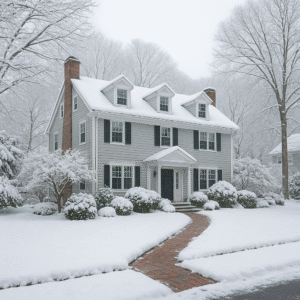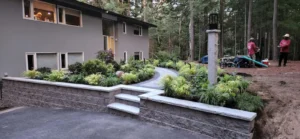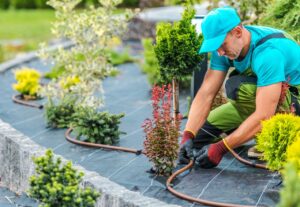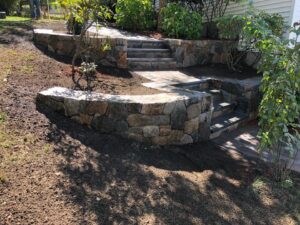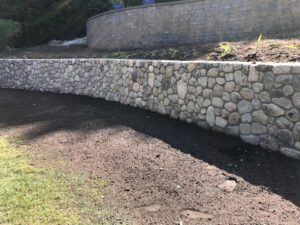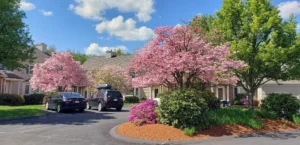Introduction: Why Smart Landscape Design Matters in Massachusetts
Designing your dream outdoor space is exciting — but without proper planning, it can quickly turn into a costly and stressful project. Massachusetts homeowners often underestimate how local weather, soil types, and plant behavior affect long-term results.
A well-thought-out landscape design doesn’t just make your property more beautiful — it also improves home value, reduces maintenance, and increases outdoor living enjoyment. Whether you live in Boston, Worcester, or the Cape, avoiding a few common landscape design mistakes can save you thousands of dollars (and hours of frustration).
Let’s explore the top 10 landscape design mistakes Massachusetts homeowners make — and expert ways to avoid them.
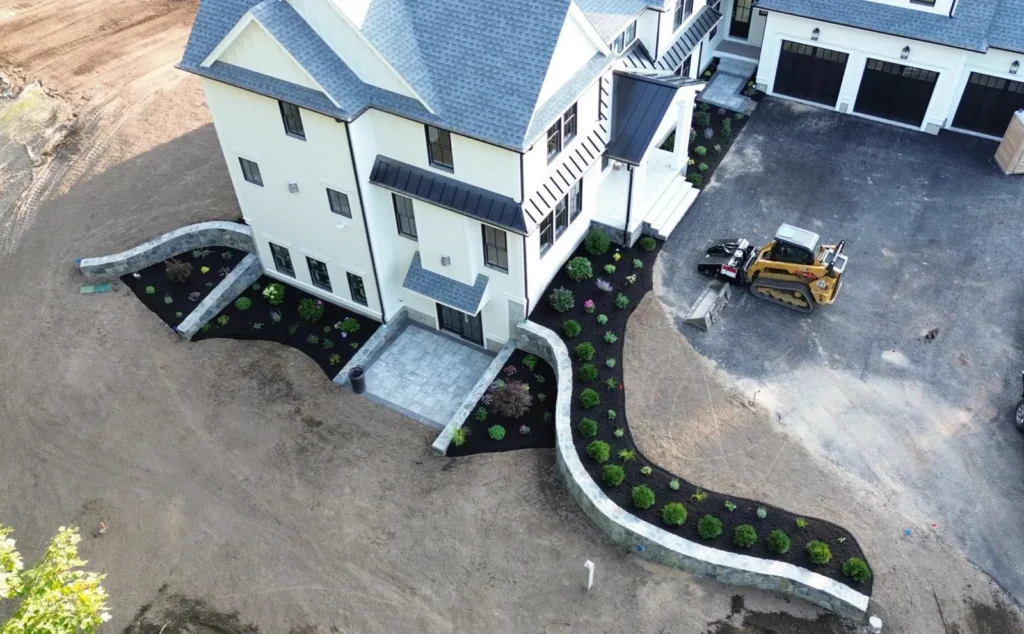
Mistake #1: Ignoring the New England Climate
Massachusetts weather can be unpredictable — hot summers, freezing winters, and sudden rainstorms. Yet, many landscape designs fail because they use plants or materials that aren’t suited for this harsh environment.
How Massachusetts Weather Impacts Landscape Choices
- Temperature Extremes: Plants like tropical species struggle in New England frost.
- Moisture Variations: Overwatering or flooding can happen during heavy rain.
- Snow Load & Salt: Driveway salt can damage plant roots and soil quality.
Pro Tip: Choose Native and Hardy Plants
Opt for native Massachusetts plants like:
- Red Maple (Acer rubrum) – thrives in wet and dry conditions.
- Eastern Red Cedar – perfect for privacy hedges.
- Black-Eyed Susan – adds color and resilience.
Native plants require less water, fewer chemicals, and minimal maintenance.
Mistake #2: Skipping the Planning Stage
Jumping straight into planting or installing patios without a plan can lead to disorganized layouts and wasted money.
Why a Design Blueprint Is Crucial
A proper landscape plan acts as a roadmap — showing plant locations, irrigation routes, and lighting placements. It also helps you anticipate maintenance and costs.
Checklist: Essential Elements for a Solid Landscape Plan
✅ Site analysis (soil, slope, sunlight)
✅ Hardscape design (patios, paths, retaining walls)
✅ Plant zoning (sun vs. shade)
✅ Irrigation plan
✅ Lighting strategy
✅ Budget allocation
Tip: Use design software or hire a professional team like Green Leaves Landscape to create a custom 3D plan.
Mistake #3: Poor Drainage and Grading
Improper drainage is one of the most overlooked issues in landscape design. Water pooling around plants or near your foundation can cause serious damage.
Common Signs of Drainage Issues
- Standing water after rain
- Soggy or muddy spots
- Erosion around walkways
- Basement leaks or mildew
How to Fix or Prevent Drainage Problems
- Install French drains or dry wells
- Use permeable pavers instead of solid concrete
- Grade soil away from the home’s foundation
- Add rain gardens to absorb excess water
Mistake #4: Overcrowding Plants and Features
We get it — lush gardens look great. But overplanting leads to competition for nutrients and limited growth.
The Right Spacing Formula for Healthy Growth
A general rule:
“Plant for the mature size — not the current size.”
Compare this:
| Plant Type | Spacing Recommendation |
|---|---|
| Shrubs | 3–5 feet apart |
| Small Trees | 8–10 feet apart |
| Perennials | 1–2 feet apart |
Give your plants room to breathe — your garden (and wallet) will thank you later.
Mistake #5: Neglecting Maintenance Needs
Some designs look stunning for the first year… then quickly fall apart due to lack of upkeep.
Design with Long-Term Care in Mind
When planning, think about:
- Growth rate of plants
- Seasonal pruning requirements
- Irrigation system maintenance
Smart Maintenance Schedule for Massachusetts Yards
| Season | Tasks |
|---|---|
| Spring | Fertilize lawns, re-edge beds |
| Summer | Inspect irrigation, control weeds |
| Fall | Leaf cleanup, aerate soil |
| Winter | Protect shrubs, plan redesigns |
Mistake #6: Forgetting About Functionality
Your outdoor space should serve your lifestyle. Maybe you want a cozy patio, a safe play area for kids, or a space for entertaining guests.
How to Balance Beauty and Practical Use
- Design pathways that connect spaces naturally
- Add seating around focal points (fire pits, fountains)
- Incorporate low-voltage lighting for safety and ambiance
Mistake #7: Ignoring Soil Health
Healthy soil = healthy plants. Many homeowners skip testing their soil — a big mistake.
How to Test and Improve Your Soil
- Test pH and nutrient levels (Massachusetts Extension offers kits)
- Add compost or organic matter
- Avoid chemical fertilizers that kill beneficial microbes
Mistake #8: Not Considering Lighting Design
Outdoor lighting adds both safety and style. It’s also one of the easiest upgrades to boost curb appeal.
Outdoor Lighting Ideas That Transform Your Space
- Pathway lights for navigation
- Uplighting to highlight trees
- Deck and step lighting for safety
- Motion sensors for energy efficiency
Mistake #9: Underestimating Budget and Time
Many projects stall because the budget wasn’t realistic.
Budget Breakdown: What to Expect in Massachusetts Projects
| Service Type | Average Cost |
|---|---|
| Landscape Design | $2,500 – $5,000 |
| Full Installation | $10,000 – $50,000 |
| Lawn Maintenance | $100 – $300/month |
Always add a 10–15% contingency fund for unexpected costs.
Mistake #10: Not Hiring a Professional Landscape Designer
DIY projects are rewarding — but for complex layouts, expert help pays off.
The Benefits of Working with Experts
- Professional planning saves time and money
- Access to quality materials and native plants
- Seamless design-to-installation process
Why Choose Green Leaves Landscape
Green Leaves Landscape is a trusted Massachusetts company specializing in:
✅ Custom landscape design
✅ Sustainable lawn solutions
✅ Full-service maintenance
📞 Ready to transform your yard?
Contact Green Leaves Landscape today for a personalized quote.
FAQs: Landscape Design Questions Answered
1. How long does a landscape design project take?
Most Massachusetts projects take 3–8 weeks, depending on design complexity and weather.
2. What are the best plants for Massachusetts landscapes?
Try native species like daylilies, switchgrass, and red maple for resilience.
3. How can I prevent soil erosion in my yard?
Use ground covers, retaining walls, or rain gardens.
4. Do I need a permit for landscape construction?
Yes, certain hardscape or grading work may require local permits. Always check with your town.
5. What’s the average maintenance cost per year?
Expect around $1,000–$3,000 annually for professional care.
6. When’s the best time to start a landscaping project?
Spring and early fall are ideal for new plantings and installations.
Conclusion
Avoiding these common landscape design mistakes ensures your outdoor space stays beautiful, functional, and sustainable for years to come.
Whether you’re starting fresh or redesigning your existing yard, don’t leave it to chance — trust the professionals at Green Leaves Landscape to bring your vision to life.
🌿 Call today or visit:
👉 greenleaveslandscape.com
👉 Contact Page

